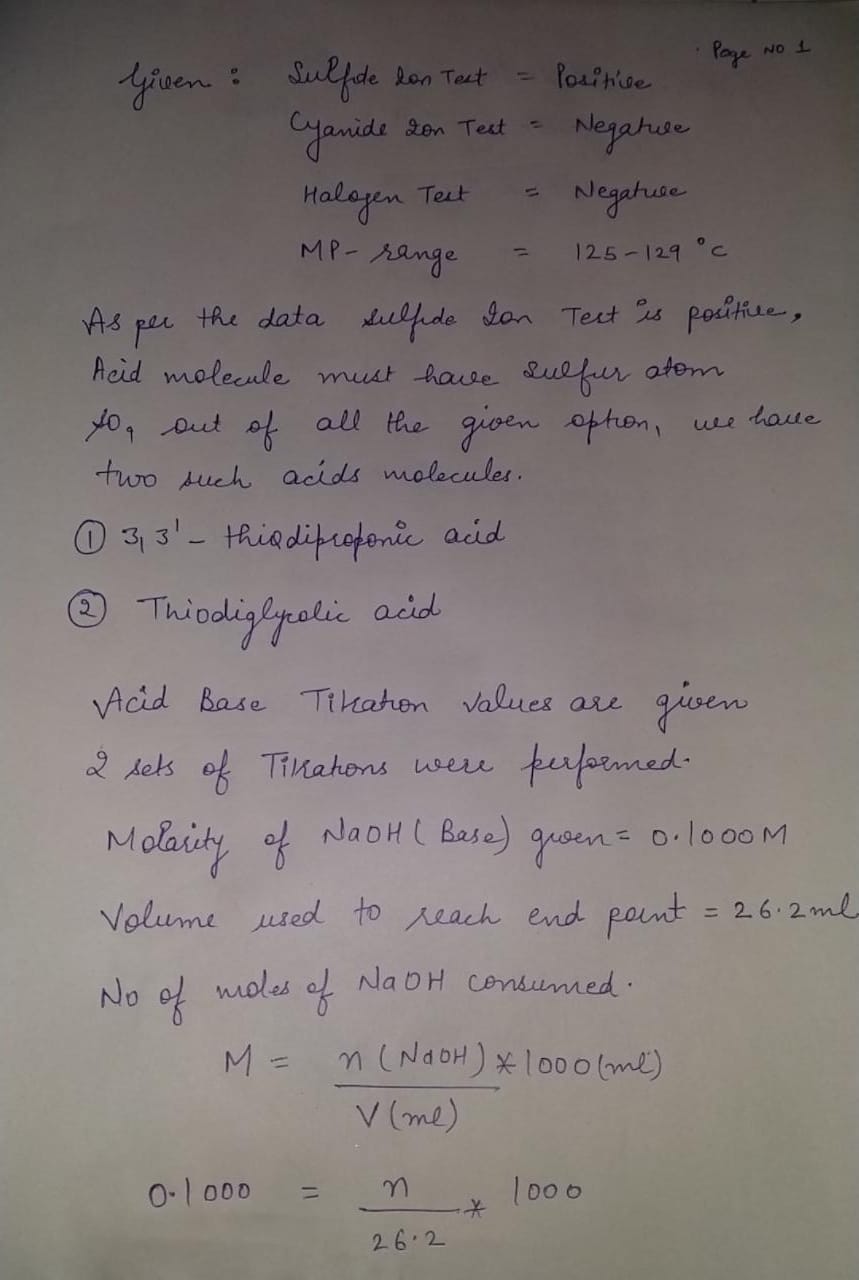Table of unknown carboxylic acids Melting Range Acid MW Melting Range Acid MW 77-78 phenylacetic 136.15 152-153 adipic (hexanedioic) *** 146.14 83-85 2,2-dimethylglutaric 160.17 155-157 3-chlorobenzoic 156.57 86-88 4-methoxyphenylacetic 166.17 155-158 3-bromobenzoic 201.02 98-100 o-anisic (2-methoxybenzoic) 152.15 157-159 4-chlorophenoxyacetic 186.59 100-102 3,3-dimethylglutaric 160.17 158-160 salicylic (2-hydroxybenzoic) 138.12 103-105 o-toluic (2-methylbenzoic) 136.2 159-162 4-chloro-3,5-dinitrobenzoic 246.56 122-123 benzoic 122.12 162-163 2-iodobenzoic 248.02 128-131 thiodiglycolic *** 150.15 180-182 p-toluic (4-methylbenzoic) 136.15 131-134 3,3’-thiodipropionic *** 178.21 182-185 p-anisic (4-methoxybenzoic) 152.15 133-134 trans-cinnamic 148.16 187-190 succinic (butanedioic) *** 118.09 139-140 2-chlorobenzoic 156.57 210-211 phthalic (benzene-1,2-dioic) *** 166.14 140-142 3-nitrobenzoic 167.12 215-217 4-hydroxybenzoic 138.12 148-150 2-bromobenzoic 201.02 239-241 4-chlorobenzoic 156.57 144-148 anthranilic (o-aminobenzoic) 137.14 239-241 4-nitrobenzoic 167.12 146-148 2-nitrobenzoic 167.12 252-254 4-bromobenzoic 201.02 150-153 benzilic (diphenylglycolic) 228.25 Using the following data, please determine the unknown carboxylic acid. Refer to Page 6 of the manuscript for the possible answers. Sulfide ion test: positive Cyanide ion test: negative Halogen test: negative MP range: 125 - 129 °C Titration of 0.200 g acid (two titrations, volume of 0.1000 M NaOH necessary to reach endpoint): 26.2 mL, 25.9 mL 3,3’-thiodipropionic thiodiglycolic 2-chlorobenzoic benzoic o-anisic (2-methoxybenzoic) trans-cinnamic 3,3-dimethylglutaric o-toluic (2-methylbenzoic)
Table of unknown carboxylic acids
Melting
Range Acid MW Melting
Range Acid MW
77-78 phenylacetic 136.15 152-153 adipic (hexanedioic) *** 146.14
83-85 2,2-dimethylglutaric 160.17 155-157 3-chlorobenzoic 156.57
86-88 4-methoxyphenylacetic 166.17 155-158 3-bromobenzoic 201.02
98-100 o-anisic (2-methoxybenzoic) 152.15 157-159 4-chlorophenoxyacetic 186.59
100-102 3,3-dimethylglutaric 160.17 158-160 salicylic (2-hydroxybenzoic) 138.12
103-105 o-toluic (2-methylbenzoic) 136.2 159-162 4-chloro-3,5-dinitrobenzoic 246.56
122-123 benzoic 122.12 162-163 2-iodobenzoic 248.02
128-131 thiodiglycolic *** 150.15 180-182 p-toluic (4-methylbenzoic) 136.15
131-134 3,3’-thiodipropionic *** 178.21 182-185 p-anisic (4-methoxybenzoic) 152.15
133-134 trans-cinnamic 148.16 187-190 succinic (butanedioic) *** 118.09
139-140 2-chlorobenzoic 156.57 210-211 phthalic (benzene-1,2-dioic) *** 166.14
140-142 3-nitrobenzoic 167.12 215-217 4-hydroxybenzoic 138.12
148-150 2-bromobenzoic 201.02 239-241 4-chlorobenzoic 156.57
144-148 anthranilic (o-aminobenzoic) 137.14 239-241 4-nitrobenzoic 167.12
146-148 2-nitrobenzoic 167.12 252-254 4-bromobenzoic 201.02
150-153 benzilic (diphenylglycolic) 228.25
Using the following data, please determine the unknown carboxylic acid. Refer to Page 6 of the manuscript for the possible answers.
Sulfide ion test: positive
Cyanide ion test: negative
Halogen test: negative
MP range: 125 - 129 °C
Titration of 0.200 g acid (two titrations, volume of 0.1000 M NaOH necessary to reach endpoint): 26.2 mL, 25.9 mL
|
3,3’-thiodipropionic |
||
|
thiodiglycolic |
||
|
2-chlorobenzoic |
||
|
benzoic |
||
|
o-anisic (2-methoxybenzoic) |
||
|
trans-cinnamic |
||
|
3,3-dimethylglutaric |
||
|
o-toluic (2-methylbenzoic) |

Trending now
This is a popular solution!
Step by step
Solved in 4 steps with 4 images









